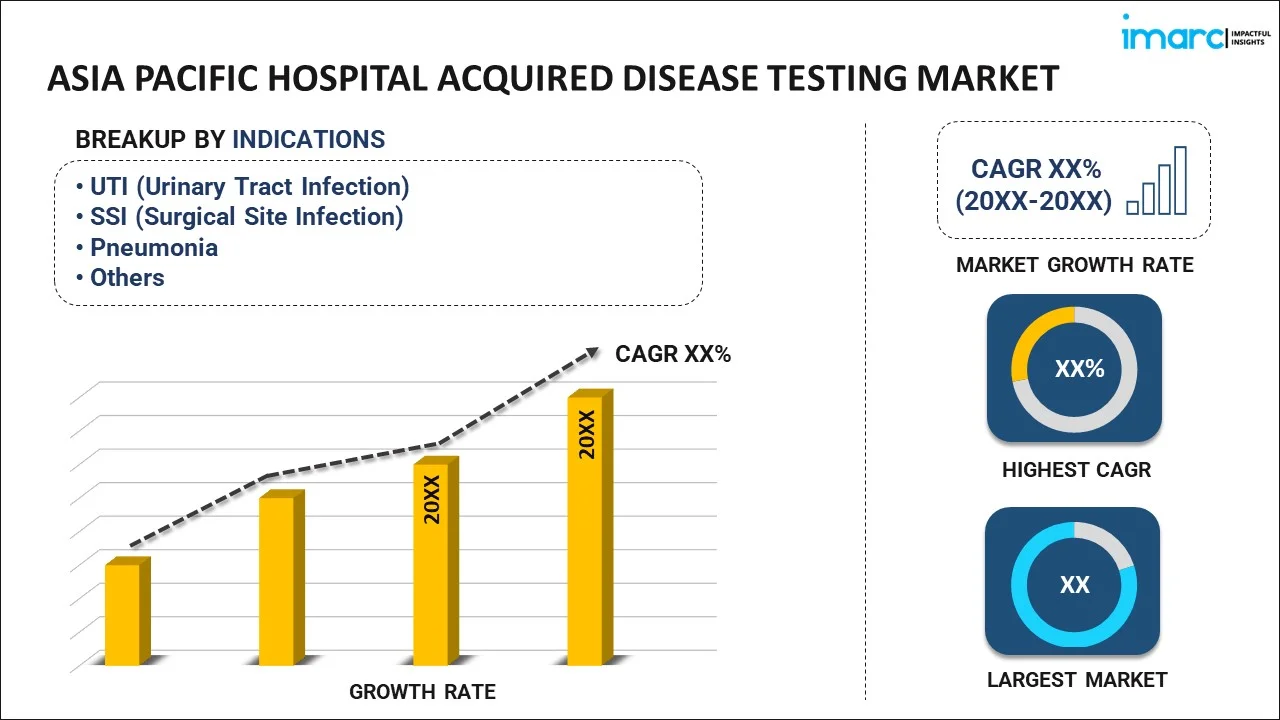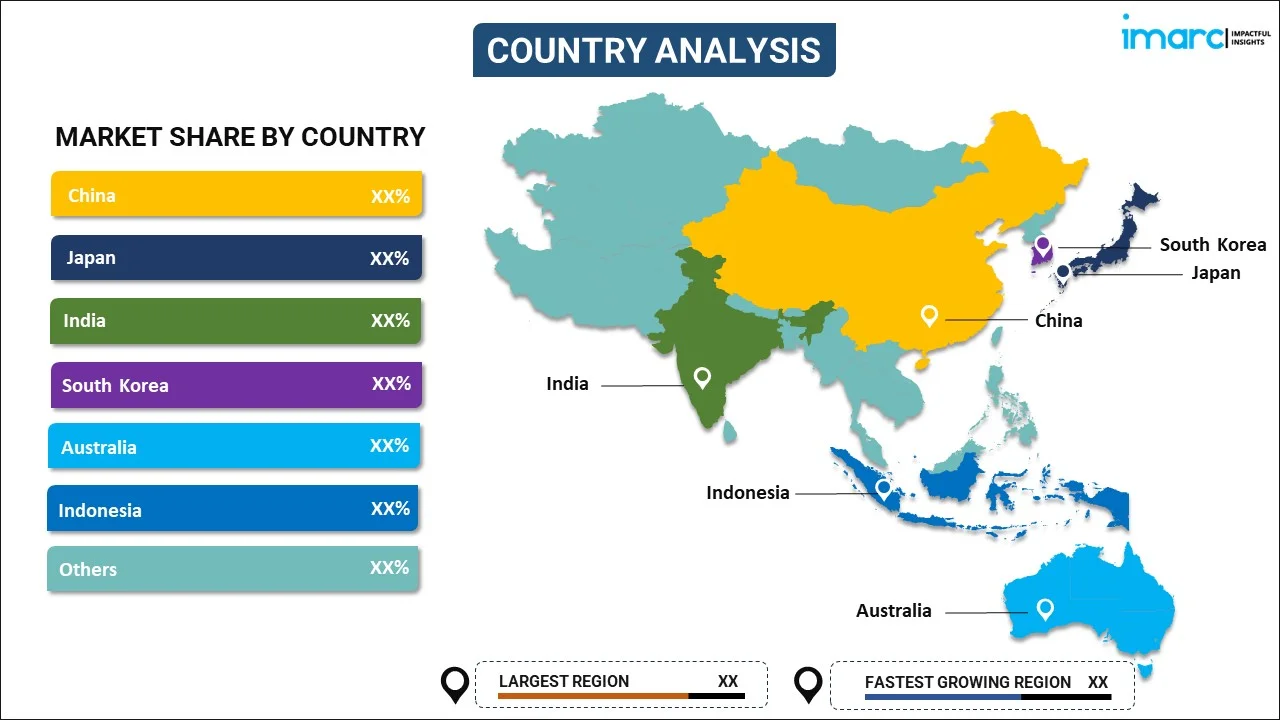
Asia Pacific Hospital Acquired Disease Testing Market Report by Indication (UTI (Urinary Tract Infection), SSI (Surgical Site Infection), Pneumonia, Bloodstream Infections, MRSA (Methicillin-Resistant Staphylococcus Aureus), and Others), and Country 2025-2033
Market Overview:
The Asia Pacific hospital acquired disease testing market size reached USD 3,188.5 Million in 2024. Looking forward, IMARC Group expects the market to reach USD 12,268.2 Million by 2033, exhibiting a growth rate (CAGR) of 15.34% during 2025-2033.
|
Report Attribute
|
Key Statistics
|
|---|---|
|
Base Year
|
2024
|
|
Forecast Years
|
2025-2033
|
|
Historical Years
|
2019-2024
|
|
Market Size in 2024
|
USD 3,188.5 Million |
|
Market Forecast in 2033
|
USD 12,268.2 Million |
| Market Growth Rate 2025-2033 | 15.34% |
Hospital-acquired diseases (HADs), or nosocomial infections, refer to the infections caused by exposure to viral, bacterial and fungal pathogens during hospital visits. Some of the commonly used techniques for testing HADs include the complete blood count (CBC) test, erythrocyte sedimentation rate (ESR) test and urinalysis, which are administered to diagnose catheter-associated urinary tract infections (CAUTI), surgical site infections (SSI) and hospital-acquired pneumonia (HAP).
The rising prevalence of nosocomial infections in the Asia Pacific region is one of the key factors driving the market growth. Being a region majorly populated by developing economies, there is a dire lack of adequate sanitation and related provisions across the healthcare sector, especially in small-scale hospitals and clinics. Consequently, patients are increasingly being exposed to multidrug-resistant bacteria (MDRB) and viruses, which, in turn, is resulting in the growing demand for pathogen detection and other HAD testing procedures. In addition to this, the implementation of favorable government initiatives to promote public health and create awareness regarding the available treatment options for HADs, are contributing to the market growth significantly. Other factors, including improvements in the healthcare infrastructure, along with extensive research and development (R&D) activities in the field of medical sciences, are anticipated to drive the market further.
Key Market Segmentation:
IMARC Group provides an analysis of the key trends in each segment of the Asia Pacific hospital acquired disease testing market report, along with forecasts at the regional and country levels from 2025-2033. Our report has categorized the market based on indication.
Breakup by Indication:

- UTI (Urinary Tract Infection)
- SSI (Surgical Site Infection)
- Pneumonia
- Bloodstream Infections
- MRSA (Methicillin-Resistant Staphylococcus Aureus)
- Others
Breakup by Country:

- China
- Japan
- India
- South Korea
- Australia
- Indonesia
- Others
Competitive Landscape:
The competitive landscape of the industry has also been examined along with the profiles of the key players.
Report Coverage:
| Report Features | Details |
|---|---|
| Base Year of the Analysis | 2024 |
| Historical Period | 2019-2024 |
| Forecast Period | 2025-2033 |
| Units | Million USD |
| Segment Coverage | Indication, Country |
| Countries Covered | China, Japan, India, South Korea, Australia, Indonesia, Others |
| Customization Scope | 10% Free Customization |
| Post-Sale Analyst Support | 10-12 Weeks |
| Delivery Format | PDF and Excel through Email (We can also provide the editable version of the report in PPT/Word format on special request) |
Key Questions Answered in This Report:
- How has the Asia Pacific hospital acquired disease testing market performed so far and how will it perform in the coming years?
- What has been the impact of COVID-19 on the Asia Pacific hospital acquired disease testing market?
- What are the key regional markets?
- What is the breakup of the market based on the indication?
- What are the various stages in the value chain of the industry?
- What are the key driving factors and challenges in the industry?
- What is the structure of the Asia Pacific hospital acquired disease testing market and who are the key players?
- What is the degree of competition in the industry?
Need more help?
- Speak to our experienced analysts for insights on the current market scenarios.
- Include additional segments and countries to customize the report as per your requirement.
- Gain an unparalleled competitive advantage in your domain by understanding how to utilize the report and positively impacting your operations and revenue.
- For further assistance, please connect with our analysts.
 Inquire Before Buying
Inquire Before Buying
 Speak to an Analyst
Speak to an Analyst
 Request Brochure
Request Brochure
 Request Customization
Request Customization




.webp)




.webp)












